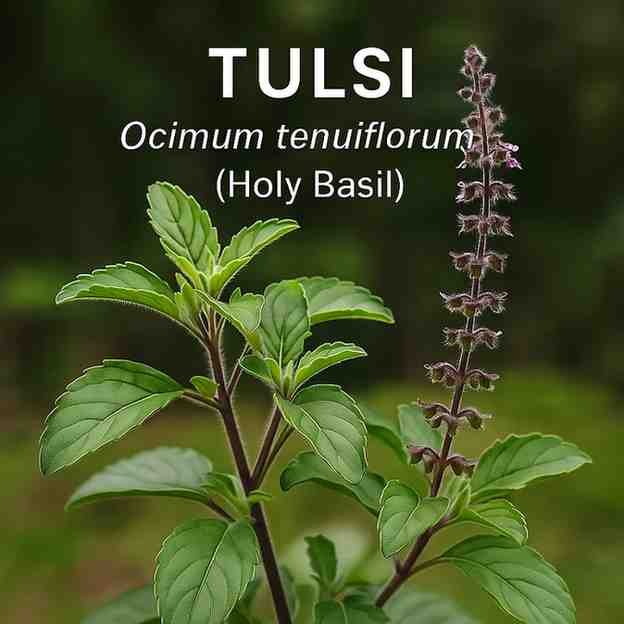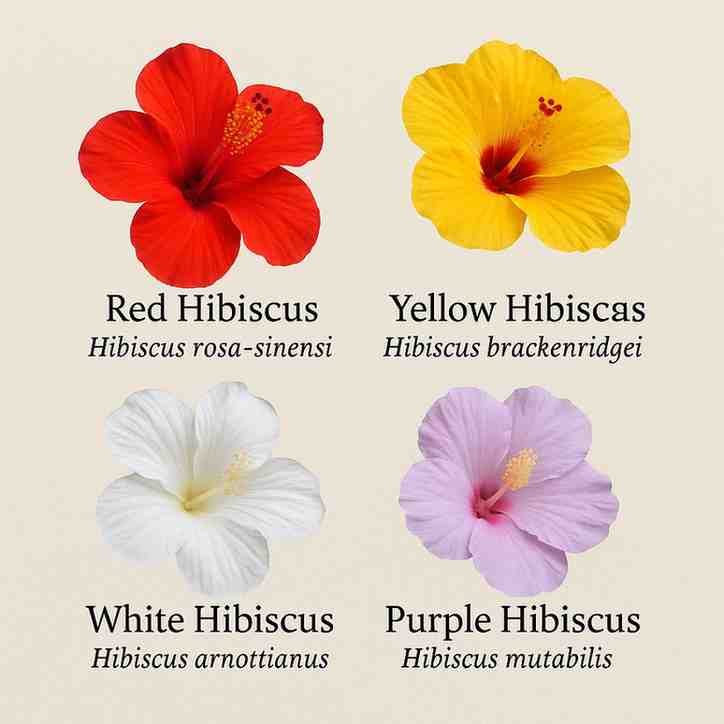What is the scientific name of the tulsi plant (holy basil)? The tulsi scientific name is Ocimum tenuiflorum.
The Indian Tulsi (holy basil) is one of the most sacred and widely used medicinal plants in the world. Apart from being an aromatic herb, it also holds great medicinal and spiritual significance in Ayurvedic medicine and Hindu rituals. It is widely found in homes, temples, and herbal gardens, and is native to the Indian subcontinent. Tulsi’s long roots in culture and proven benefits still live up to its name as a natural remedy for a wide range of physical and mental ailments.
In this article, we will discuss everything about the scientific name of Tulsi, its pronunciation, and botanical classification, as well as its many medicinal uses, benefits, types, and more.
Table of Contents
What is the Scientific Name of Tulsi?
The official biological name of Tulsi
Ocimum tenuiflorum; also known as Ocimum sanctum. It is commonly called Holy Basil in English.
Meaning of the full scientific name of tulsi
- Ocimum is derived from the Greek word okimon, which means fragrant herb.
- The word Tenuiflorum means “having thin or delicate flowers.”
Pronunciation of Tulsi Scientific Name
- How to Pronounce Ocimum tenuiflorum
- Ocimum: /ˈɒs.ɪ.məm/ or /ˈoʊ.sɪ.məm/
- Tenuiflorum: /ˌtɛ.nju.ˈfloʊ.rəm/
- Phonetic Spelling and Guide
- OSS-ih-mum | ten-yoo-FLO-rum
Different Botanical Names (Holy Basil)
- Sacred Basil
- Tulasi (Sanskrit)
- Ocimum sanctum (older name from the Netherlands)
- Holy Basil
Botanical Classification of Tulsi Plant (holy basil)
| Rank | Classification |
|---|---|
| Kingdom | Plantae |
| Clade | Angiosperms |
| Clade | Eudicots |
| Order | Lamiales |
| Family | Lamiaceae |
| Genus | Ocimum |
| Species | tenuiflorum |
In this classification, basil is placed among the fragrant flowering plants, closely related to other herbs such as basil, mint, and sage.
Size, Shape, and Structure of Tulsi Plant
Typical Plant Height:
Tulsi is about 1 to 2.5 feet (30 to 75 cm) high, depending on the type and climatic conditions. Under ideal conditions, it can grow taller and bushier, provided it receives regular care and attention.
Leaf Length and Texture:
Leaves are generally 2–4 cm long, soft in texture, ovate with a somewhat toothed margin. These are piercingly aromatic and turn a little purplish based on the variety.
Flower Description:
Tulsi bears small white to purple flowers, which are borne in vertical spikes. These open during the warmer months and are important for pollination and seed setting.
Where is the Tulsi Plant found? Native Habitat & Regions
Native to the Indian Subcontinent:
Basil is native to the Indian subcontinent, particularly India, Nepal, and Sri Lanka, as well as neighboring regions. Here, it thrives in either tropical or subtropical climates, where it can be grown outdoors year-round.
Environmental Requirement:
The ideal growth condition for Tulsi is 6-8 hours of sunlight exposure, well-drained, fertile soil, and moderate watering, as it is drought-resistant and does well in most instances of low-maintenance gardens.
Cultivation at Home and Abroad:
The tulsi plant is found growing in every corner of the world, primarily in Southeast Asia, the Middle East, Africa, and even parts of the United States where the climate permits.
Different Types of Tulsi (Holy Basil)
There are multiple species and varieties of the Tulsi plant. Each type has unique properties and appearance.
1. Rama Tulsi (Green Tulsi)
- Light green leaves
- Sweet and mild fragrance
- Commonly used in herbal teas
2. Krishna Tulsi (Shyama Tulsi)
- Dark purple leaves and stems
- Stronger aroma and taste
- Preferred in Ayurveda for immunity
3. Vana Tulsi (Wild Forest Tulsi)
- Native to forests
- Woody stems and highly aromatic
- Used in traditional remedies
4. Kapoor Tulsi (Used In USA)
- Known for fast growth
- Often cultivated in the US
- Used as an ornamental and medicinal herb
Medicinal Benefits of Tulsi (Holy Basil)
Tulsi is one of the most powerful herbs in Ayurveda, known for its healing effects. The plant is often called the “queen of herbs.“

- Immune Booster:
- Strengthens natural immunity
- Fights against infections and viruses
- Respiratory Relief:
- Effective for asthma, bronchitis, colds, and coughs
- Clears congestion naturally
- Stress & Anxiety Control:
- Adaptogen herb
- Balances cortisol and stress hormones
- Heart and Liver Health:
- Reduces cholesterol
- Supports liver detoxification
- Skin & Hair Benefits:
- Anti-bacterial, anti-inflammatory
- Used in face packs, hair oils, and shampoos
Culinary and Herbal Uses of Tulsi Leaves
This plant is an herb of promise, more medicinal than culinary, used in tea, pills, and remedies:
- Tulsi Tea: This one is a strong antioxidant beverage
- Tulsi Extract: For use in syrups and tonics
- Herbal Capsules: This one’s a daily supplement
- Fresh cold leaves: Used for chutneys or salads
Common Names of Tulsi in Different Languages
| Language | Common Name |
|---|---|
| English | Holy Basil |
| Hindi | तुलसी (Tulsi) |
| Urdu | تلسی (Tulsi) |
| Sanskrit | तुलसी (Tulasi) |
| Tamil | துளசி (Thulasi) |
| Telugu | తులసి (Tulasi) |
| Bengali | তুলসী (Tulsi) |
This universal herb holds respect and utility in various cultures and regions.
How to Grow Tulsi at Home
Growing Tulsi is the simplest thing to do, and when it grows, it gives happiness.
Ideal Conditions
- 6 to 8 hours of sunlight daily
- Water every 1 to 2 days (don’t overwater)
- Use clay pots that allow drainage
- Apply compost once every 3 weeks
Some Maintenance Points
- Prune regularly to encourage branching.
- Keep warm from frost or extreme cold
- Remove any dried leaves falling so as not to promote fungal growth
Interesting Facts About Tulsi
- Tulsi emits oxygen even at night.
- The first talk-at-tulsi all night long, mosquitoes, and insects.
- Tulsi is used in religious rites and temple worship
- The leaves are used in holy water (charanamrit)
- Balances vata, pitta, and kapha doshas in Ayurveda
Conclusions
Tulsi (Ocimum tenuiflorum), also known as holy basil, holds a strong place in traditional medicine and Indian culture. The importance of tulsi is supported by tulsi scientific name, botanical classification types of Rama, Krishna, and Vana, and many medicinal properties. Tulsi leaves are considered extremely valuable for daily maintenance, healing of diseases, religious, and spiritual ceremonies.
Also Read:
Hibiscus Scientific Name and Uses: Benefits, Growth, and Meaning
FAQ
What is the tulsi scientific name?
Ocimum tenuiflorum or Ocimum sanctum
Are tulsi and holy basil the same?
Yes, they are the same plant. “Holy basil” is the English name.
Can tulsi leaves be eaten daily?
Yes, 3–5 fresh leaves a day are safe and beneficial for health.
What are the benefits of tulsi tea?
Improves immunity, detoxifies the body, and reduces stress.
Can tulsi grow indoors?
Yes, place it near a sunny window with regular watering.

